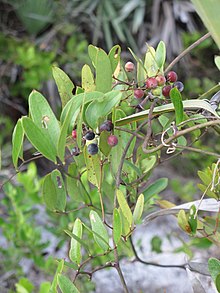Smilax laurifolia
| Smilax laurifolia | |
|---|---|
 |
|
| Scientific classification | |
| Kingdom: | Plantae |
| (unranked): | Angiosperms |
| (unranked): | Monocots |
| Order: | Liliales |
| Family: | Smilacaceae |
| Genus: | Smilax |
| Species: | S. laurifolia |
| Binomial name | |
|
Smilax laurifolia L. 1753 not Roxb. 1832 |
|
| Synonyms | |
|
|
Smilax laurifolia is a species of flowering plant in the greenbrier family known by the common names laurel greenbrier,laurelleaf greenbrier, bamboo vine, and blaspheme vine. It is native to the southeastern United States, where it occurs along the Gulf and Atlantic coastal plains from Texas to New Jersey, the range extending inland to Arkansas, Oklahoma, and Tennessee. It also occurs in Cuba and the Bahamas.
This plant is a monocotyledonous woody vine that forms dense colonial thickets and climbs over other vegetation. The stems reach five meters or more in length. They are "viciously armed" with prickles that may be over a centimeter long. The plant grows from a huge woody, tuberous rhizome. The sprouts may grow up to 7 centimeters per day. The leathery evergreen leaves are linear, lance-shaped, or oval and reach 13 centimeters long by 6 wide. The petioles twist to bear the leaves in an erect position. The inflorescence is an umbel of up to 25 flowers borne in the leaf axils. Each flower has whitish or yellowish tepals each about half a centimeter long. The fruit is a shiny, waxy black berry 5 to 8 millimeters long. The berries mature in the second growing season after they first appear.
This plant grows in bogs, swamps, and marshy areas. It is a dominant plant in pocosins. The soils are wet to saturated and the sites are often flooded. It is common in the Everglades and it is "characteristic" of the Okefenokee Swamp understory flora. It grows beneath cypress, swamp blackgum (N. sylvatica), white bay (Magnolia virginiana), loblolly bay (Gordonia lasianthus), sweet bay (Persea borbonia), red maple (Acer rubrum), cassena (Ilex cassine), titi (Cyrilla racemiflora), and southern white cedar (Chamaecyparis thyoides). In the understory it is associated with hurrahbush (Lyonia lucida), leucothoe (Leucothoe racemosa), sweetspire (Itea virginica), poor-man's soap (Clethra alnifolia), coral greenbrier (S. walteri), and honeycup (Zenobia pulverulenta).
...
Wikipedia

